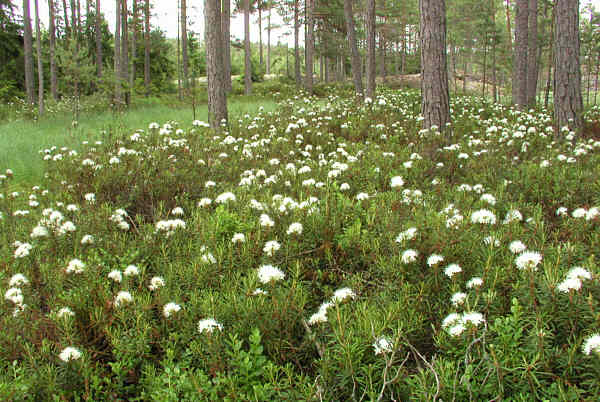
| Paluu dokumenttiluetteloon / Back to the catalogue of various documents on rhododendrons |
Lepidote Crosses in 2003 using
Rhododendron tomentosum
as Seed Plant
Kristian Theqvist, 09-Aug-2006, rev. 019

|
| Figure 1. Rhododendron tomentosum shrubs are flowering in June on the marsh near to my garden. |
| Pollen (father) | Swelling ovaries / Total | Comments |
| Non-pollinated stigmas as control | 0 / 11 | This was to verify that the pollination method with emasculated flowers and covered stigmas was good. |
| groenlandicum | 8 / 9 | Expected good result as groenlandicum is closely related to tomentosum. |
| hypoleucum | 1 / 9 | I had an extremely small amount of pollen from hypoleucum. Otherwise the result would probably have been better. |
| dauricum | 5 / 8 | Pretty interesting, if gives seedlings. |
| ledebourii | 5 / 8 | Same result as for dauricum. Some regard ledebourii as a regional variation of dauricum. |
| cinnabarinum var. cinnabarinum | 5 / 8 |
This was a big surprise and totally unexpected! Probably the seeds do not germinate, but still I'm impatiently waiting for extraordinary results.
|
| minus (Milde) | 4 / 7 | Could this be true? Very interesting cross, if it gives seedlings. |
| hippophaeoides | 2 / 7 | This could also yield to quite interesting hybrids. |
| minus (Hachmann) | 2 / 8 | Very interesting, if gives seedlings. |
| impeditum | 1 / 8 | Not much pollen. |
| 'P.J.M. Elite' | 1 / 7 | Pretty interesting, if gives seedlings. |
| 'Ramapo' | 1 / 8 | 6 out of 7 stigmas and ovaries dried out. Reason is unknown. May be I squeezed the style a little bit too much during pollination? |
| 'Blumiria' | 1 / 8 | 6 out of 7 stigmas and ovaries dried out. Reason is unknown. Squeezed style? |
| 'Dörte Reich' (minus x cinnabarinum Concatenans) (picture © Glendoick Gardens) | 1 / 8 |
6 out of 7 stigmas and ovaries dried out. Reason is unknown. Squeezed style? The results from the remaining seed capsule could be very interesting. |
| 'Robert Seleger' | 0 / 10 | All 10 stigmas and ovaries dried out. Reason is unknown. Squeezed style? |
| 'Mother Greer' | 0 / 8 | Probably not a compatible cross. |
| minus, pink (Göteborg) | 0 / 8 | Probably not a compatible cross. |
| kiusianum | 0 / 7 | Probably not a compatible cross. A very expected result. |
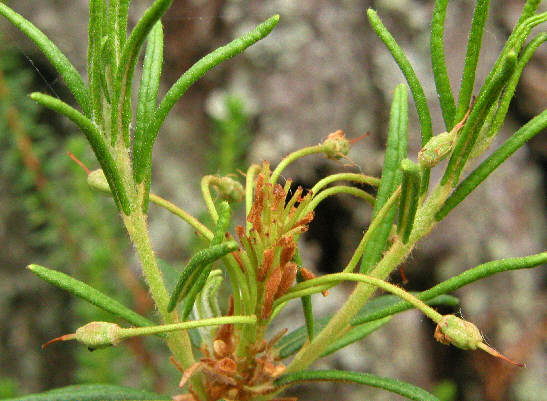
|
| Figure 2. Swelling and elongating ovaries on the cross tomentosum x ledebourii three weeks after pollination. |
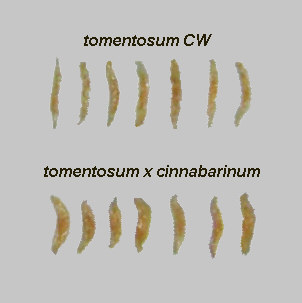
|
| Figure 3. Seeds from the cross tomentosum x cinnabarinum as compared to wild tomentosum seeds. |
| Pollen (father) | Germination percentage 2 weeks after sowing | Comments |
| groenlandicum | 90 % | Nice looking seedlings. |
| hypoleucum | 55 % | Nice looking seedlings from the very few seeds. |
| dauricum | 22 % | Small, weak looking seedlings. |
| ledebourii | 30 % | Small, weak looking seedlings as for dauricum! |
| cinnabarinum var. cinnabarinum | 100 % |
Very vigorously growing, good looking seedlings. Specially large, round cotyledon leaves. |
| minus (Milde) | 72 % | Nice looking seedlings. |
| hippophaeoides | 77 % | Nice looking seedlings. |
| minus (Hachmann) | 100 % | Nice looking seedlings. |
| impeditum | 0 % | No seedlings from the very few seeds. |
| 'P.J.M. Elite' | 25 % | Nice looking seedlings. |
| 'Ramapo' | 38 % | Small, weak looking seedlings from the very few seeds. |
| 'Blumiria' | 60 % | Some nice looking, but mostly small, weak seedlings. |
| 'Dörte Reich' (minus x cinnabarinum Concatenans) (picture © Glendoick Gardens) | 67 % | Nice looking seedlings from the very few seeds. |
| tomentosum CW | 100 % | As comparison wild collected tomentosum gave good germination, but the seedlings had considerably smaller and narrower cotyledon leaves than most of the hybrid crossings. |
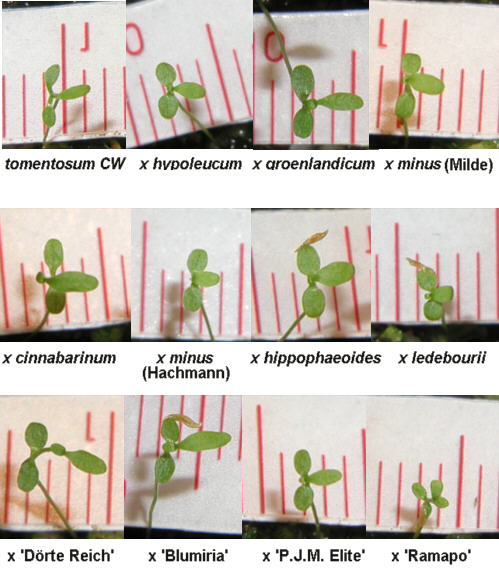
|
| Figure 5. First true leaves of the tomentosum crossings. |
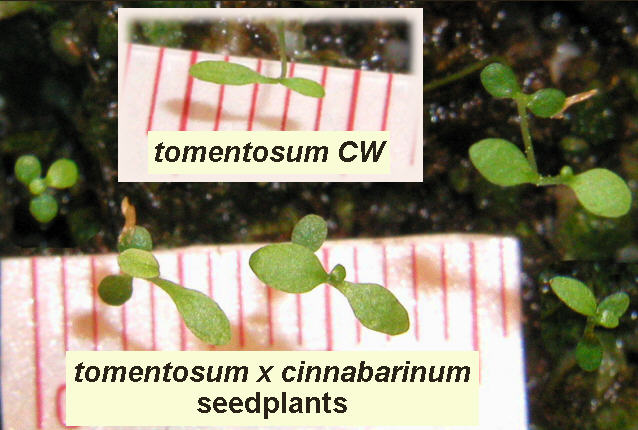
|
| Figure 6. Seed plants tomentosum x cinnabarinum compared to a tomentosum CW seed plant. (The scale unit is 1 millimeter.) |
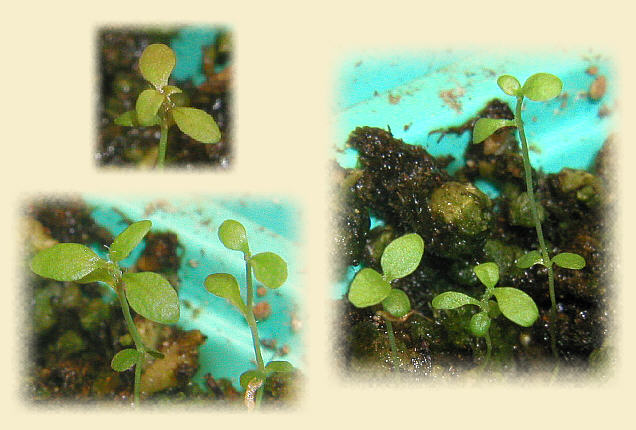
|
| Figure 7. The hybrid tomentosum x cinnabarinum seed plants are growing nicely and are now 12 weeks old. One of the plants has markedly darker leaves (upperleft picture). |
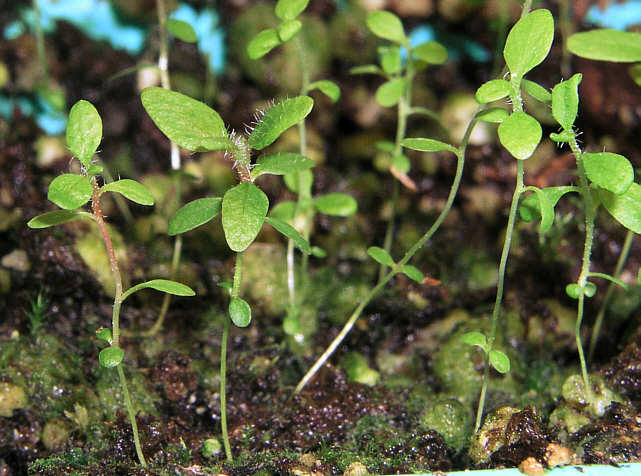
|
| Figure 8. The hybrid tomentosum x cinnabarinum seed plants show distinctive variation at an age of 15 weeks. |
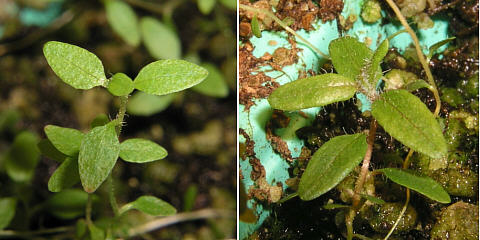
|
| Figure 9. On the right is one of the tomentosum x cinnabarinum seed plants and on the left tomentosum CW. More of these with large variation can be seen at Pictures of tomentosum seed plants. |
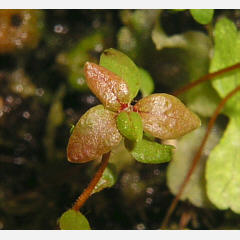
|
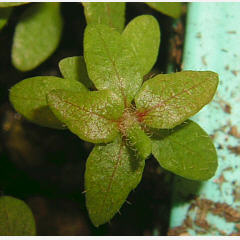
|
| Figure 10. One of the tomentosum x cinnabarinum seed plants. | Figure 11. One of the tomentosum x hippophaeoides seed plants. |
|
|
|
| Figure 12. One of the tomentosum x dauricum seed plants. | Figure 13. One of the tomentosum x minus (Hachmann) seed plants. |
Status 17-Dec-2004 on tomentosum crosses
The seed plants from my 2003 crosses are now one year old and growing well after having a long several month break in growth during our cool summer. The plants probably
felt that winter started when I brougth them out in June to temperatures close to 0°C (32°F) or even below freezing. Now the plants are again in my room at +20°C (68°F).
Most of the seed plants have inherited more features from mother R. tomentosum than from the pollen given lepidote. However, in all of the crosses there are plants that clearly differ from the R. tomentosum.
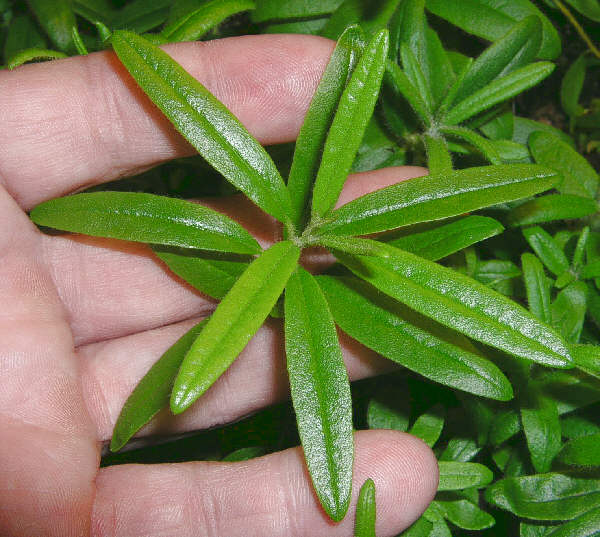
|
| Figure 14. This is one of the most beautiful seed plants, a cross R. tomentosum x dauricum. The leaves are long and narrow as on mother tomentosum, but totally glabrous, without hairs as on the pollen given R. dauricum. |
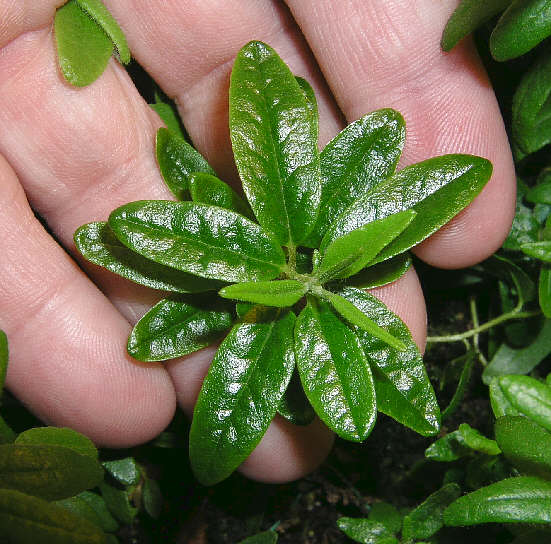
|
| Figure 15. The glabrous leaves of R. tomentosum x ledebourii are inherited from R. ledebourii (variation of dauricum). The growth is very dense. |
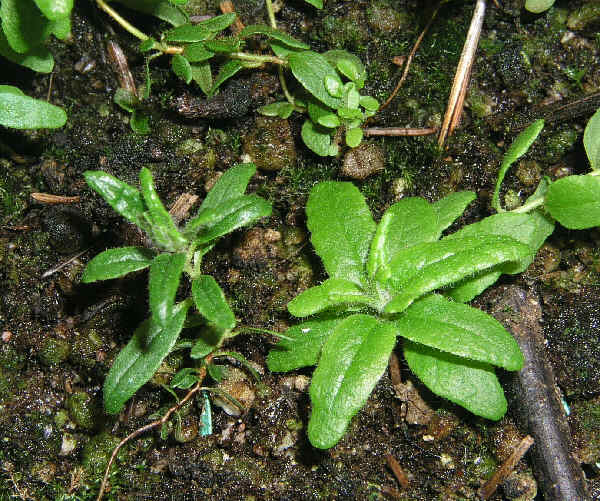 |
|
Figure 16. On the left is a glabrous, narrow leaved R. tomentosum x hippophaeoides and on the right a hairy, wide leaved R. tomentosum x minus. On top of the picture is partly seen another R. tomentosum x hippophaeoides plant, this one with more rounded leaves. |
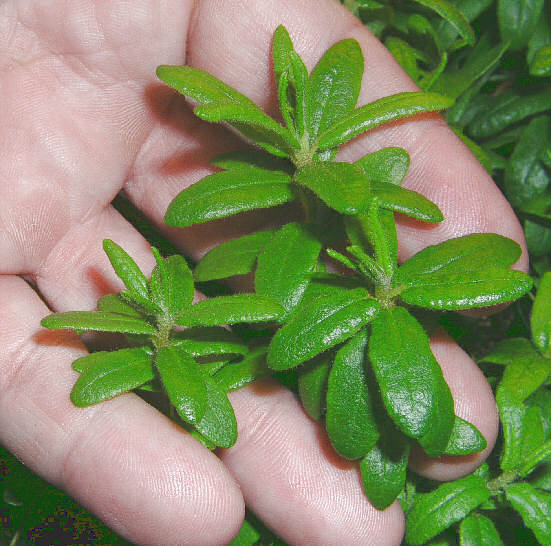 |
| Figure 17. R. tomentosum x hippophaeoides seed plant has wider and shorter leaves than tomentosum. |
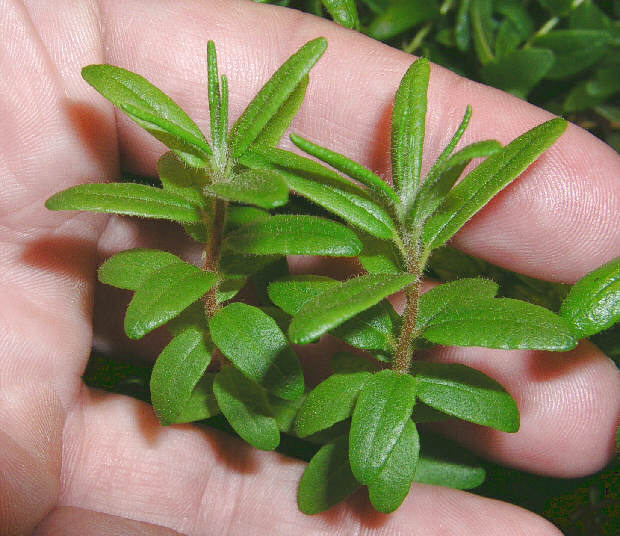 |
| Figure 18. R. tomentosum x cinnabarinum seed plant has shorter and wider leaves than tomentosum. The stalks are exceptionally dark red and very hairy. |
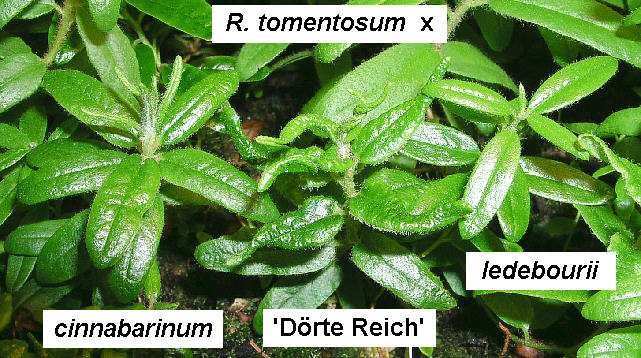 |
| Figure 19. Three different crosses and as a result three very different looking plants. On the left is R. tomentosum x cinnabarinum with nice hairy leaves, somewhat wider than on tomentosum. In the middle is R. tomentosum x 'Dörte Reich' with strange-looking twisted and very hairy leaves. New growing leaves are curled around each other. On the right is R. tomentosum x ledebourii with almost glabrous, straight leaves. (All plants are different from the previously shown ones.) |
Status 25-Apr-2004 on tomentosum crosses
I gave the seed plants a two month artificial winter at +5°C to +10°C. The growth stopped and several plants got some "autumn" colors on the leaves.
In March I got the plants back in at +25°C. I pinched off the top of each plant and good new growth has started.
I took pictures of some of the now 77 week old seed plants and made a picture gallery that can be seen at Pictures of 77 week old R. tomentosum cross seed plants.
I placed a white paper with 1 cm (0.4 inch) grid to the backgound to make it easier to compare the size of the plants.
A typical R. tomentosum CW plant is shown in the first picture of the gallery as reference.
One of the R. tomentosum x cinnabarinum seed plants has two different types of new growth. On some branches the new leaves are smooth shaped and normal looking, but on some branches the leaves are twisted and somewhat malformed looking. I noticed this growth habit already last spring, but that time it was not so obvious. Some kind of mutation when the chromosome pairs do not match? See picture below.
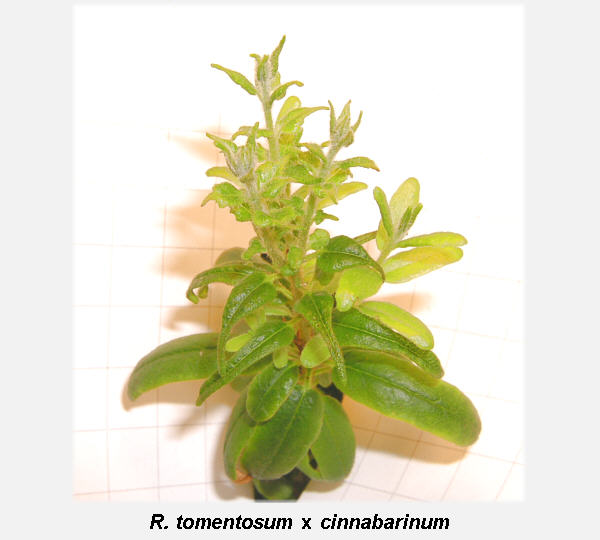 |
| Figure 20. R. tomentosum x cinnabarinum seed plant with two different types of new growth: smooth shaped, normal looking leaves on some branches and twisted, malformed leaves on some. Non-matching chromosome pairs? |
Status 09-Aug-2006 on tomentosum crosses
The seed plants were last winter first time out and without any winter protection. The lowest temperature was not that low, only down to -20°C (-4°F), but without help from
any snow cover. I have now counted the losses and registered how each cross survived the winter. The results are shown in figure 21 and a comparison between x groenlandicum
vs. x cinnabarinum in figure 22.
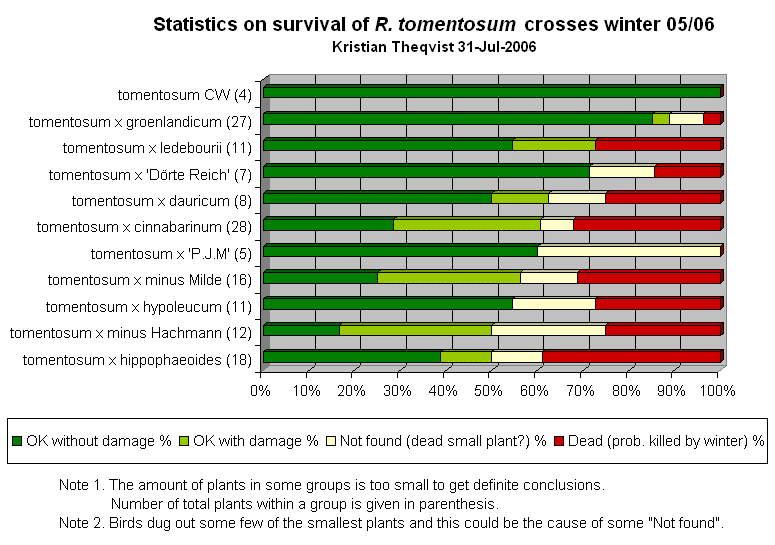 |
|
Figure 21. Winter survival of tomentosum crosses during winter 05/06. |
Some comments on the winter survival results are given in next table.
| tomentosum CW | Another nine plants from same batch were planted in other location. No damage, all OK. |
| tomentosum x groenlandicum | As expected, very good survival rate and minimal winter damage. |
| tomentosum x ledebourii | The batch included some weak looking plants which did not survive. Otherwise good survival rate. |
| tomentosum x 'Dörte Reich' | Surprisingly good survival. One of the plants is vigorous with larger and wider leaves than tomentosum CW. |
| tomentosum x dauricum | The batch included some weak looking plants which did not survive. Otherwise good survival rate. |
| tomentosum x cinnabarinum | One third dead, one third got damaged leaves and one third survived without damage. |
| tomentosum x 'P.J.M' | Some small weak-ones could not be found anymore. Surviving plants without damage. |
| tomentosum x minus Milde | Surprisingly low survival rate. R. minus is not fully hardy in S. Finland. |
| tomentosum x minus Hachmann | Surprisingly low survival rate. R. minus from Hachmann is not fully hardy in S. Finland. |
| tomentosum x hypoleucum | The cross resulted unexpectedly in several weaklings that did not survive the winter. |
| tomentosum x hippophaeoides | R. hippophaeoides is marginally hardy in S. Finland and gets easily damaged and even killed. |
As a conclusion it seems that pollen given lepidotes have affected the hardiness of the hybrid plants but fortunately the mother R. tomentosum has given some good genes.
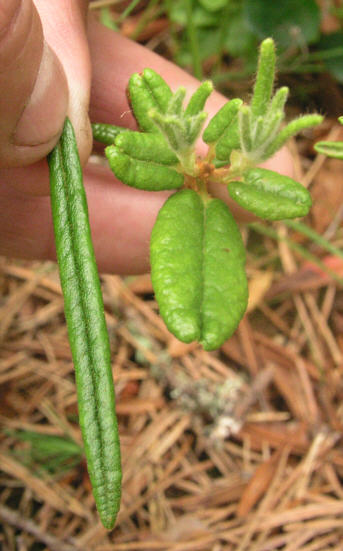 |
| Figure 23. R. tomentosum x 'Dörte Reich' with wide growing leaves on the right as compared to largest R. tomentosum CW leaf that I found from the marsh. |
I'll report on the growth of the seedlings on this page whenever something worthwhile reporting happens.
Pictures of 19 week old R. tomentosum cross seed plants
Pictures of 25 week old R. tomentosum cross seed plants
Pictures of 34 week old R. tomentosum cross seed plants
Pictures of 77 week old R. tomentosum cross seed plants
Pollinations in 2004 using R. tomentosum as Seed Plant
Pollinations in 2005 using R. tomentosum as Seed Plant
Pollinations in 2006 using R. tomentosum as Seed Plant
Leaf pictures of R. tomentosum cross seed plants
Taxonomy of species in Rhododendron subsection Ledum
Hybridity of lepidotes in Rhododendron subsection Ledum based on some hybridization results
Breeding Hardy Elepidote Rhododendrons in Finland